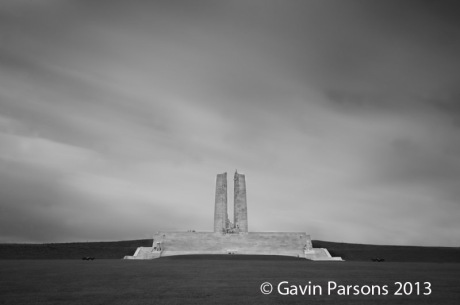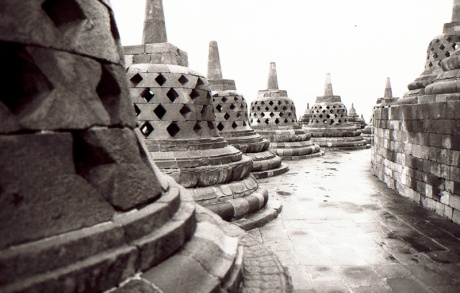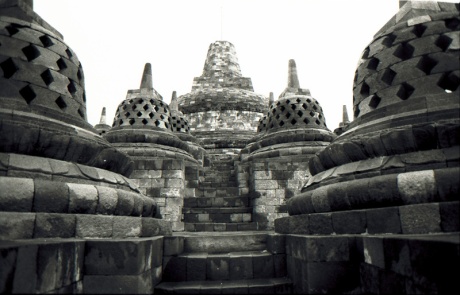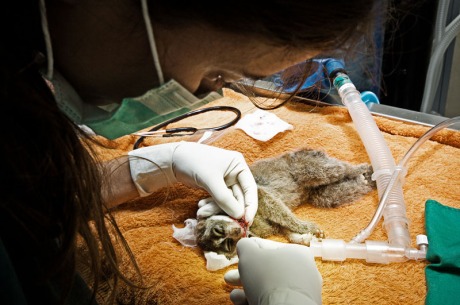
The Commonwealth Graves Commission Cemetery Canadian Cemetery No.2, which is located in the Vimy Ridge Memorial Park. The well tended lawns are the last resting place of soldiers from a number of Commonwealth countries including the UK.
I yelled “Stop, stop stop,” from the back seat. And then said two words, my traveling companions really wanted to hear: “Iron Harvest.” A few metres back down the country track lay three rust and mud caked munitions from a war that is almost a century old. So fierce was the fighting that even today you can stand by the edge of a newly ploughed field and pick up lumps of shrapnel, barbed wire and other spurious pieces of metal which cut hundreds of thousands of men to shreds. The mortars, shells and bombs are still pulled from the ground by farmers, construction workers, utility workers and gardeners.

A shell, motor round and unidentified munition left as ‘iron harvest’ on the side of a farm track. Even now, almost 100 years after the guns fell silent, farmers still uncover remnants of the First World War.
One reason for the sheer amount of unexploded ordinance still surfacing is the vast tonnage fired by the protagonists of the First World War. It churned the ground of France and Belgium to a soft squidgy mess, which eventually wasn’t substantial enough to detonate one on four shells fired. That means almost a century of live munitions coming to the surface. Some are high explosive rounds, which are not nearly as dangerous any more as the mustard gas shells. But farmers and ground workers still die or are wounded each year, and the Iron Harvest keeps the army bomb disposal experts of France and Belgium busy.
The small collection of shells we found included a standard shell, a Crapouillot (Little Toad) 20kg A.L.S trench mortar round and a smaller British mortar round. We were tempted to move them to get a more pleasing picture, but suicide was not on the agenda, so we made the best of where they sat. As I lay on the ground photographing live First World War ordinance The Voice of Edmund Blackadder filled my head after Lieutenant George asked the procedure after stepping on a mine: Blackadder: “Well, normal procedure, Lieutenant, is to jump 200 feet into the air and scatter yourself over a wide area.” It was not something I wanted to test, but the excitement of finding such a tangible part of Europe’s bloodiest conflict, almost got the better of me. I had not expected to find such a real part of the war so early on the trip.
THE FALLEN
I’d come to France and Belgium to tread in the footsteps of heros and to create a photographic record of the journey. Basing ourselves in Lille (which was cheaper than the Front line towns of Ypres, Zonnebeke or Lens.) Myself and two friends set out each day to explore the surrounding area.
After the first morning, it was obvious we’d made the right choice to only stay a few days and to concentrate on the small area of the Ypres Salient and Vimy Ridge. The impact of seeing the graves of so many young men was enough to put a ball of emotion in the bottom of my stomach, which grew with each cemetery we visited. After the first day we’d all got cemetery fatigue.
We started though at Vimy Ridge, the site of a large Battlefield Park. Driving to the massive Canadian Monument it’s obvious why the area is a park. The shell pocked ground has been left untouched and ‘Danger Live munitions’ signs are everywhere. The cost of clearing it now would be astronomical.

Canadian National Vimy Memorial the centre piece of the 100 hectare Vimy Ridge battlefield park. It was designed by Walter Seymour Allward and took eleven years to build. It was opened in 1936. Upon its walls are the names of fallen and lost Canadian Soldiers who have no known grave.
Vimy Ridge was highly prized by both sides and a fierce battle raged here for most of the war and culminated in the Canadian attack on the ridge which was part of the Battle for Arras started on 9th April 1917. Months of tunnelling, shelling and trench warfare ended in a routing of the German 6th Army in just four days and the capturing of the high ground. The battle is a defining moment for the Canada Army and Vimy Ridge was chosen to commemorate the huge sacrifice the men paid to take the ground.
A massive memorial to the missing was constructed in 1924. Designed by Toronto sculptor and designer Walter Seymour Allward. While waiting for the stone to arrive from Croatia, Allward got his construction workers to preserve lengths of trenches and the tunnels dug by allied troops. The legacy is, therefore, a park which encompasses the memorial, tunnels, trenches, cemeteries and a forest of trees growing among the pulverised ground. It is a place for the fallen to rest completely in peace.
The Memorial, like the famous Menin Gate, is covered in the names of Canadian soldiers who have never been found. It is a peaceful place, but the munition infested earth surrounding it is a stark reminder of the ferocity of the Battles that raged here for several years. The cemeteries also serve as reminder to the cost many young men, not just from Canada, paid to take this piece of ground from occupying forces.
The exposed ridge is subject to all sorts of weather and on a breezy day makes a perfect place to use a long exposure to render the sky into a blur, thus showing the steadfast resolve of the monument to tell the world forever of the terrible four years which paid Vimy Ridge a visit between 1914 and 1918.
THE PRICE PEACES PAYS TO PROGRESS
After the tranquility of Vimy Ridge we headed to two cemeteries we’d seen from the main road. Finding them proved a little confusing. The Commonwealth War Graves Commission is very good at putting up sign posts, but we had to travel in the opposite direction to where we thought to get to the farm track that lead to the cemeteries. We found the Arras Road cemetery a mile down the track, but it was right next to the main N17 from Arras to Lens, which is a dual carriageway and the constant droning of cars and lorries was distracting and not very sombre. The cemetery though is, like all the Commonwealth War Grave Commission cemeteries, immaculately kept. I again chose a long exposure of around a minute to give the cemetery a sense of stoic belonging in its surroundings. It shows how the sky moves on, the trees move too, but the stones of the fallen remain and will do so forever.

Arras Road Commonwealth War Graves Commision cemetery. It is the last resting place of over 1000 Commonwealth soldiers mainly from the UK and Canada.
The sensation of ‘forever’ was highlighted perfectly at the next cemetery we visited. The Beehive cemetery holds just 47 British and Canadian soldiers. It was a forward burial site and named after a German machine gun emplacement the British troops thought looked like a Beehive. Today the small cemetery is a kilometre into the ploughed fields of the flatlands below Vimy Ridge. It is surrounded by corn and sugar beet, and is a sacred place with a well tended lawn enclosed by a small wall. In my opinion it is a lovely place to rest in peace.
The diminutive Beehive cemetery is in contrast to the British cemetery on the outskirts of the French village of La Targette a few miles away. Not because this cemetery is by a busy road or that it is on a completely different scale as it holds around 640 soldiers. No, the reason for the contrast is the neighbours. While the Beehive soldiers are surrounded by farmland, the La Targette cemetery inhabitants are next to the French National Cemetery and the British dead are dwarfed by the sheer number of French. Many of the soldiers here died in 1915 while France fought a horrendous battle against a well defended and dug in German enemy while trying to retake the Artois Hills. Thousands and thousands died as the huge scale of the cemetery shows. The stone crosses, set in neat lines go on seemingly forever.
The Germans were far from immune to the cataclysmic casualty rates too and a couple of miles up the road is the Neuville-Saint-Vaast German Cemetery, the largest Germany cemetery on the western Front. Over 44,000 soldiers lie here. It is a place which slowly wraps a hand around your throat and grips you to choking point. It is a desperately sad piece of ground, where melancholy hangs in the air and drips from the trees. Lines of black crosses stretch off into the distance and each cross signifies the burial of two, three and even four soldiers.
Perhaps it was the culmination of seeing so many dead young men, but the German cemetery kicked my resolve to the curb and I was done. I didn’t want the reality of First World War in my life for the rest of the day.

German WWI Cemetery at Neuville St Vaast, France. This is the largest German cemetery in France and contains over 43,000 German soldiers from the First World War. There are generally 4 soldiers per grave, although Jewish German soldiers are marked with a simple head stone rather than a metal cross.
MESSING UP MESSINES
There is very little actual evidence that evil visited this small part of Belgium from 1914 to 1918. There are a handful of crumbling bunkers and a few metres of preserved trench, but mostly the land has been turned back to agriculture, villages and towns. There are no trees older than a century, and precious few buildings either. One thing that will never disappear completely though are the mine craters. And the Allied attack on the Messines Ridge in June 1917 created a series of massive craters in a small area when the British and Australia troops attacked and took the Messines Ridge, one of the most successful battles of the First World War.
The craters are just large circular ponds these days, but they are shocking all the same. The Messines Ridge is littered with them, the most famous is the Hoodge Crater, as it lies next to the main road, although several are accessible from the small lane called Kruisstraat, which runs north west out of the town of Mesen and basically follows the German front line. If you are looking for something a lot more authentic and out of the way, then head to Railway Wood, just off the Menin Road. Here we discovered a small crater behind the memorial to eight British tunnellers and another deep in the dense undergrowth of the wood. The latter gave a sense of discovery and I got a feeling that this was a little visited parts of the First World War and like the Iron Harvest, it was something that directly connected me to the men who fought and died here.

A hidden mine crater in Railway Wood, one of the little visited sites of the First World War.
That evening after driving along the front line of the Messines Ridge we stopped in the walled city of Ypres, one of the focal points of the Great War. Ypres today is a thriving city bursting out of its medieval walls, which makes its living from the fact it was decimated by the First World War. It’s Flanders Museum is a hub for visitors to the battlefields and one of the best commemorative museums I have ever visited.
The main reason to visit Ypres though is the Menin Gate, a foreboding emblem to the lost of the war. It is a hard place to describe. The massive white stone gateway is covered in almost 55,000 names of the soldiers who were never found. A number which is unfathomable. It is shocking and disturbing, but not the only reason to visit the Menin Gate, because at 8pm each evening the men of the Ypres Fire Brigade step in front of hundreds of visitors and represent the entire Belgium nation in saying thank you to the men who gave their lives to save Belgium’s freedom. They play a haunting rendition of The Last Post with bugles and I defy anyone to stand there after seeing so many white headstones and not have a lump in their throat. The only time since 1927, when the Menin Gate was opened, when the Last Post hasn’t been played there was during the Second World War. But it restarted as soon as that part of the Town was liberated. Proof, if any were needed, that the small country of Belgium knows how to say thank you with style and honour.
TO REALLY REST IN PEACE
As the centenary of the start of the First World War creeps nearer like an artillery barrage, more and more visitors will come to this relatively small sliver of Europe which was the Western Front. Thankfully, the sites are not here for fun. France and Belgium have worked hard to keep the remembrance as serene and sombre as possible. This is aptly demonstrated at Tyne Cot, the largest Commonwealth Cemetery in the world. The site between Zonnebeke and Passendale consists of a cemetery with near 12,000 graves and a memorial to the missing that commemorates some 35,000 soldiers who were never found.
It is a vast cemetery and like all the others tended by the Commonwealth War Graves Commission, it is immaculately kept. A visitor centre at the top of the cemetery is the first place to stop and as I walked from the carpark to the centre I became aware of a soft female voice whispered on the wind. At first it was hard to hear, especially as there was a coach tour just leaving, but as I concentrated I could hear names. The voice is on a loop and speaks the names of each of the 34,887 commonwealth soldiers who appear on the memorial to the missing. It’s a heart wrenching addition to the visual enormity of the sacrifice The Commonwealth Soldiers made and gives Tyne Cot perspective and creates a humbling experience.
Tyne Cot is peaceful and deliberately so. There are reminder signs telling you it’s a place of remembrance and anyone insulting that sense will be asked to leave. Yet it’s one of the most visited places on Battlefield tours and so I wanted to find a cemetery where the residents can truly rest in peace. Many of the cemeteries are close to main roads, or in fields were farm machinery trundles by, but I wanted to find a setting that was truly a place for eternal rest.

The Buttes New British Cemetery is the last resting place of 378 New Zealand soldiers who died during fighting in Beligium, mostly in 1917.
In the end I found it, a place worthy of the title ‘Rest In Peace’. Set in Polygon Wood is the Buttes New British Cemetery and across a small road next to a field with chickens and a friendly donkey is Polygon Wood Cemetery.
Most of the soldiers here were bought from other cemeteries after the war ended. What these men have been given, in thanks for their lives, is a beautiful and serene last resting place. The woods screen the minimal traffic noise and the only sounds you hear is nature continuing to reuse the ground that was once smashed and devoured by war.
I came to France and Belgium to find remnants of the First World War and was initially disappointed by the lack of evidence except for some Iron Harvest and the odd dilapidated bunker. But the experience changed my view. The Great War is now, for me, not about the fighting, it is about the men who died. Ensuring they are remembered for the ultimate price they paid. Finding Polygon Wood a peaceful place gave me a renewed sense of acceptance of the First World War. I had no ancestors who fought on the Western Front and because of that I have a slightly different perspective. I want the best for all of them, Commonwealth, Allied, German, Austro-Hungarian.
The cemeteries enrich the landscape of the French and Belgium countryside and serve as a reminder to the world of what not working together can do to humanity. We must not forget that, and overthe next century, when the gravestones will stay still and the munitions will still creep up from the ground, mankind will hopefully keep the years the world went mad at the forefront of our minds.
To see the full set of images from this story click through to my website gallery at www.gavinparsons.co.uk/pages/worldwarone.html



















